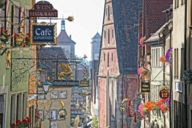
Two and a half hours to the north west of Munich lies Rothenburg ob der Tauber, a place which is seen abroad as the prototypical medieval German town. Its intricate alleyways, enchanted towers and little squares with timber-framed houses have provided the backdrop for films about Martin Luther and the Brothers Grimm.
- Rothenburg and its history
- The old town of Rothenburg
- Rothenburg on the Romantic Road
- Rothenburg: How to get there from Munich
The town’s origins date back to the 12th century, and many of its original gates, towers and walls have been preserved. Rothenburg was one of the most powerful cities in the south of the country in the Middle Ages and a proud imperial city from 1274 to 1803, but its political influence and wealth declined following the Thirty Years’ War. However, this was also a good thing, as Rothenburg has only developed slowly and largely preserved its medieval appearance. Many buildings were destroyed during the Second World War but have been faithfully reconstructed.
If you take a stroll through the narrow streets, you’ll feel like you’ve travelled back in time. Everything looks seamlessly original with hardly any modern buildings. The old town is surrounded by accessible city fortifications, and the vast, untouched expanse of the Tauber valley can be seen in the background. It’s no wonder Rothenburg is seen as one big architectural treasure, attracting millions of visitors from all over the world every year. Nobody wants to miss out on the opportunity to visit arguably the most famous town in Germany on their journey through Europe.
In 1950, Rothenburg became one of the highlights along the Romantic Road, the oldest and one of the most popular holiday routes in Germany. The idea was to restore Germany’s status as an attractive holiday location after the Second World War. The Romantic Road is over 400 kilometres long, featuring numerous attractions between Würzburg and Füssen.
In Rothenburg, it crosses paths with another holiday route, the Castle Road, and so lots of tourists are attracted to the area, where they can attend events like the well-known Taubertal Open-Air Festival, the Christmas Market, the Imperial City Days and the “Meistertrunk”, a historic festival held every year during the Whitsun weekend that was recognised as a piece of cultural heritage in 2016. Käthe Wohlfahrt’s Christmas Museum, the Handwerkerhaus (Craftsman’s House), the Imperial City Museum and the Criminology Museum are other popular tourist attractions.
Even Pope Francis used to live here when he was still the simple Father Jorge Mario Bergoglio. He attended a German course at the Goethe-Institut in Rothenburg and lived with a host family on Judengasse from August to October 1986. Who knows whether he also tried the good wine that grows all along the slopes around Rothenburg.
Train connection: approx. 3 - 3.5 hours. Information at bahn.de
Car: approx. 3 hours via the A9 and A6 motorways or alternatively via the A8 and A7 motorways